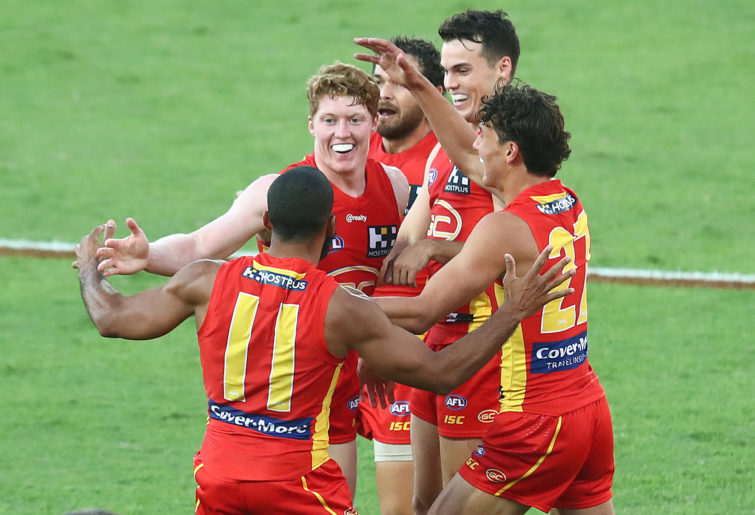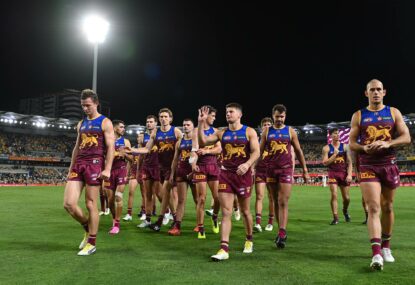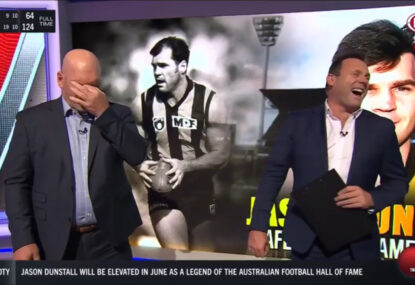You would assume that a league ladder would be evenly balanced from top to bottom, wouldn’t you?
After all, there are going to be exactly as many wins as losses, and as many points scored as there are points given up. So the average record should be .500, and the average percentage would always be 100per cent, right?
As far as that goes, yes. Those assumptions always hold.
But it’s how those wins and points are spread out that helps us understand how healthy or sickly a league might be at any point in time. If one team always wins and shuts out its opponents, there’s going to be a skew to the numbers that calls out for attention.
When the AFLW split into conferences for the first time three years ago, the overabundance of strong teams on one side of the ledger called into question the fairness of the finals structure, and at that point there simply wasn’t going to be much anyone could do about it.
If we take a look at what’s been happening in the men’s league since expansion a decade ago, some questions come up that deserve our attention – especially if we’re serious about adding a 19th team in Tasmania or a 20th somewhere else.
A caveat: this is not a recommendation for or against expansion, or anything else. I’m just a numbers guy. Nowhere in this treatise are dollars and cents considered.
All we’re looking at is ladder balance today, which is just one small factor in the health of a league.
Let’s begin.
In the four years before the Giants entered competition in 2012, there were three teams that hit the 20-win plateau: Collingwood in 2011 (20-2), St Kilda in 2009 (20-2), and Geelong in 2008 (who tied the 21-1 record of the 2000 Dons, slightly exceeding their percentage at 162 per cent).
Tangential to our topic, it’s curious to note that all three lost in the grand final, so gaudy records do not guarantee championships.
In the nine seasons completed since then, however, the only team to come close to that landmark was the 2013 Hawthorn club that did capture a flag (and the next two as well) with a 19-3 home-and-away record.
The closest since 2013 was the 2018 Richmond team who went 18-4, won their only minor premiership, and were eliminated in a prelim final by an American just starting to understand how the game was played.
Ironically, that was the only year of the four most recent when the Tigers didn’t take the flag.
The first-place records throughout the last decade were generally 17-5 or so, unless a pandemic reduced them to 14-3. Even more curious are the percentages: The 20-2 Magpies that were upended by the 19-3 Geelong Cats in that 2011 GF had a percentage of 167.7 per cent, and the Cats weren’t far behind that.
But no team since has broken 160 per cent for a season; in fact, in the last four years, as the expansion talent has diluted across the league, no team has even surpassed 140 per cent (the high-water mark is Port’s 136.4 per cent last year over 17 games).

Port Adelaide coach Ken Hinkley and assistant coach Michael Voss. (AAP Image/Ben Macmahon)
Here’s another set of data to consider: while last year had nine teams on each side of the ‘midpoints’ (nine winning records of 9-8 or above; nine teams with percentages over 100 per cent), every season over the prior decade tilted significantly towards having more teams in the top ‘half’ than the bottom.
In 2019, there were 10 teams out of the 18 above 100 per cent. 2018 was the year that Adelaide placed 12th with a 12-10 record and the 12th-best percentage of 104 per cent.
In 2017, St Kilda was 11-11 in 11th. Bulldog fans fondly remember when there were six teams with records of 16-6 or above in 2016, and they weren’t one of them.
Geelong missed a game when Adelaide’s coach, Phil Walsh, passed away in 2015 and ended with the unusual record of 11-9-1, putting them only in 10th place, with the 11th best percentage of 101 per cent. Ten teams had percentages above 105 per cent in 2013; 11 were above 102 per cent in 2012.
These were the norm over the last decade because there was a figurative weight at the bottom of the league during much of it in the form of Gold Coast and, at times, GWS.
Expansion does that; catastrophically poor clubs do that to a league. That’s why there’s been such a concern about the quality of the Suns organisation – weak teams make for bad games. (Come back soon, Matt Rowell. And bring a healthy ruckman with you…)

Matthew Rowell of the Suns (Photo by Jono Searle/AFL Photos/via Getty Images )
If you go back to the beginning of the old VFL in the last few years of the 19th century, you’ll see the same effect.
Although St Kilda were one of the foundational clubs in the creation of the national sport, playing recorded games as far back as 1858, the team that was put together in its name when the Victorian Football League began play in the 1897 season hardly did justice to that history.
Those Saints went 0-48 over their first three seasons of 1897-99, becoming one of the few teams in any sport who can honestly claim to have gone zero-for-the-century.
The final Saints game of the 1800s was especially heinous: Geelong needed a big win in the hope of qualifying for the GF, so they ran up the unbelievable score of 162 to 1 on the hapless southside crew (it turned out South Melbourne had already clinched the berth before that game, but news travelled slowly back then).
The Saints were gifted a win in arbitration in season four thanks to a too-quiet three-quarter buzzer, and finally won one on the field in 1901 before going winless again in 1902.
The collateral damage, in a manner of speaking, was to the table the Saints shared with seven other clubs.
Because St Kilda was so bad, fielding a 29 per cent that first year and surpassing that with a percentage of 28 per cent in 1899 that still stands as the record, the other clubs had two free routs per season added to their tallies.
Truthfully, in that initial season it was four walkovers, as Carlton would have otherwise been considered a terrible team were it not for the presence of those now-legendary Saints. The Blues went 2-12 with a percentage of 60, those two wins coming at St Kilda’s expense.
Their first match ended 35-24, the only vaguely competitive match the Saints played that year. The week before, Carlton lost to Melbourne 107-26, and the next week saw St Kilda lose to Geelong, 114-31. In contrast, the average score in the league that season was a mere 38 points.
Hence, even sixth-place Fitzroy, with a paltry record of 4-9-1 (two wins over the Blues, two over the Saints, and a tie with South Melbourne), had a gaudy percentage of 104.9! The other five teams all had winning records (in an eight-team league) and percentages ranging from 114 to 184.
The distortion effect works from the top down, too. In that 2011 season with a 20-win Collingwood and a 19-win Cats team, you also had an 18-win Hawthorn club in third and a 17-win West Coast team in fourth.
Those percentages were phenomenal – 168, 157, 144, and 130 (add in fifth-place Carlton with a 131 percentage as well).
But below that? The ninth-place Kangaroos (out of 17) was below .500; the eighth-place Bombers hold the most recent example of a perfect percentage of 100 per cent (2217 points for, 2217 against), but it got them into the finals!

Dyson Heppell (Photo by Michael Willson/AFL Photos via Getty Images)
Three teams had 18 or more losses – besides fledgling Gold Coast, Brisbane and Port Adelaide (who had shared an epic GF just seven years before) had only seven wins between them. There simply weren’t many victories left to go around.
What’s the point of all of this?
By eliminating these ‘distortions’, are we gradually coalescing as a league towards the ultimate ‘goal’ of every team within three games and 15 percent of average?
At this pace, will we bequeath to our children or theirs a 24-team league with a 24-game schedule (once around plus a second Derby, of course) that ends with a 24-way tie for first at 12-12 and perfect percentages of 100 per cent each?
Is that when the Norm Smith Participation Medals are handed out and we give every team member juice boxes and orange slices and celebrate at whatever pizza parlour is closest to the MCG at the time? Will even the medical subs get the same number of orange slices as the stars do?
There was the solution, right there. Hidden in that last stupid joke.
The solution is talent. The stars will prevent the homogenisation of the league. We may be able to balance out everything else across the league, but you can’t give every team a Dustin Martin.
Not every team can have a Patrick Dangerfield. There’s only one Lance Franklin, one Eddie Betts, one Adam Goodes, one Gavin Wanganeen… for that matter, there’s only one Erin Phillips, one Daisy Pearce, one Madison Prespakis.
And they’re all unique.
Every game situation is different, and every star is suited to different moments when their unique talents allow them to rise to the occasion.
Watching Phillips kick the only first half goals against a Melbourne team on a five-game win-or-go-home streak under difficult weather conditions reminds us that it takes a star to rise to some occasions, to overcome what seemed an insurmountable edge in the opposition’s possession.

Erin Phillips (Photo by Mark Brake/Getty Images)
That’s why Phillips and her Adelaide teammates are likely to win their third premiership in the half-decade history of the women’s league.
That’s why Martin, Jack Riewoldt and the Tigers have three of the last four AFL cups in their trophy case back in Richmond’s headquarters, when the league seems more balanced than ever.
And that’s why some unspecified club will be shooting for its fourth-straight grand final victory in 2037 when the odds seem stacked higher against them every season, with all the other 21 clubs gunning (nope, can’t say ‘gunning’ in 2037)… shooting for (note to self: no ‘shooting’, either!)… all the other clubs are circling that game date on their calendar, hoping to defeat the reigning champs.
And maybe those reigning champs, with that superstar who’s only now finished potty training, will finally put together that perfect 22-0 home-and-away in that 2037 season, the 140th anniversary of the beginning of the VFL.
And maybe, they’ll follow that up with three decisive finals wins and the grand final capper to a 25-0 season, the digital confetti raining down on the MCG while writers wax poetic describing the Golden Age of Footy in glowing terms on that first Saturday in October.
(And Gold Coast will quietly celebrate having put together its first winning season ever at 12-9-1 that year, defeating both Hobart and Launceston in the last two rounds to achieve their third-of-a-century dream of finishing ninth.)






































































































